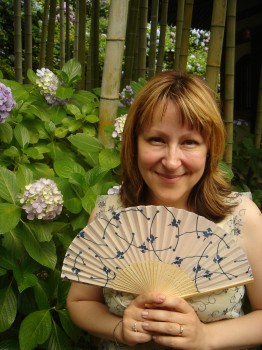Between three cultures
5 February 2010 | Authors, Reviews
A new collection of short stories by the Leningrad-born author Zinaida Lindén explores the ambiguities of life between three cultures: her native Russia, her adopted Finland, and Japan, where she has also lived. In this introduction to Lindén’s short story Shards from the empire, Janna Kantola appreciates Lindén’s capricious, recalcitrant prose, and the positive, generous spirit that lies behind her work
Seen from a distance, Finns and Russians seem very like one another.
Zinaida Lindén has written her books from a cultural no-man’s-land in which she may have been forced to ponder the central questions of national identity. After studying Swedish in her native Russia, Lindén (born 1963) settled in Finland with her Finland-Swedish husband, and has written all of her works in Swedish. A recurring theme is that of encounters with the foreign, the other.
Lindén’s novel I väntan på en jordbävning (‘Waiting for an earthquake’), extracts of which were published in Books from Finland 4/2004) takes place between Russia and Japan; the Russian sumo wrestler-cum-fireman Ivan Demidov talks about his life to a Russian writer who has moved to Finland. The novel was awarded the 2004 Runeberg Prize for Literature. In the novel Takakirves – Tokyo (‘Takakirves – Tokyo’, 2007), the same Mr Demidov writes a series of letters to Finland.
Demidov does not appear in the collection of short stories, Lindanserskan (‘The tightrope-walker’, Söderströms, 2009; Finnish translation, Nuorallatanssija, Gummerus), but Finns, Russians and the Japanese encounter one another all the same. The writer’s own history – she has also spent a year in Japan – may explain this somewhat exotic combination.
The collection is a veritable balancing act between cultures, right down to its title. Can it be a coincidence that the metaphor of the tightrope walker was one used in literature to describe Finland’s balancing act between the pressures of east and west? As the motto of his thriller The Tightrope Men (1973), set partially in Finland, Desmond Bagley even went as far as to quote Bertrand Russell’s words about the fate of the tightrope walker. Russell makes the point that it is reasonable to assume that the tightrope walker may stay on the rope for ten minutes, but unreasonable to think he might continue without falling off for another two hundred years.
In the title story, the narrator claims that children make excellent acrobats because they do not experience fear due to their lack of life experience. Although these stories do not seem to uphold the myth of the Finns’ wild reputation, they might lead readers to think of our young nation in the light of that same fearlessness. For Lindén, however, this quality is linked to those balancing between two cultures; to the young Russian woman in the title story, who cannot but notice how stubborn Finns can be. Lindén has commented that she is often compared to the female characters in her works, to their thoughts and opinions, but says that she is in no way trying to depict herself.
Those who lump Finns and Russians together – or the author and her characters, for that matter – would be advised to think again: one thing the narrators in these stories have in common is their refusal to accept generalisations, which, on the other hand, does not prevent them from coming up with generalisations of their own. It is claimed in one of the stories that what Finnish and Japanese men have in common is their inability to flirt with women. (Having said that, the story also notes that, whereas a Japanese man will not dance even if you hold a gun to his head, many Finnish men go dancing voluntarily.)
The attraction of these ten stories lies in their sympathetic but capricious narrators, for whom growing up in the Soviet Union has provided perspective and a feel for the absurd. They always surprise us. That same temperament is reflected in the structure of the stories too: though these stories often end abruptly, they still end well. In their closing observations, everyday matters are elevated, sometimes to the point of aphorism.
When, over sixty years ago, the literary researcher V. Kiparsky attempted to document ‘The notions of the Russian people regarding Finland and the Finns’ as represented in literature, the results were not altogether flattering. Even Dostoyevsky has a Finnish character, the ‘unfriendly, crooked-nosed cook’, who with her continued silence drives her mistress to distraction.
Although Finnish taciturnity is a subject dealt with in Lindén’s short stories, Finnishness is generally viewed in a rather positive light. You would have trouble finding Finnish men as docile as the ones Lindén depicts. Part of the reason for this lies in the narrators’ positive outlook on the world in general, something that, in a moment of poetic fervour, one might call a quality of the Russian soul.
Translated by David Hackston
Tags: identity, short story
No comments for this entry yet
Leave a comment
Also by Janna Kantola
For the love of fables - 1 February 2009
On life and death - 30 September 2007
-
About the writer
Janna Kantola (born 1971) is a Senior Lecturer in the Department of Comparative Literature, Institute of Art Research, University of Helsinki as well as a literary critic and translator.
© Writers and translators. Anyone wishing to make use of material published on this website should apply to the Editors.

